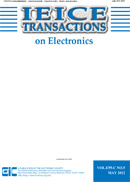
- |<
- <
- 1
- >
- >|
-
Katsuya OHISHI, Takashi HISAKADO, Tohlu MATSUSHIMA, Osami WADAArticle type: PAPER
Subject area: Microwaves, Millimeter-Waves
2018Volume E101.CIssue 12 Pages 923-930
Published: December 01, 2018
Released on J-STAGE: December 01, 2018
JOURNAL RESTRICTED ACCESSThis paper describes the equivalent-circuit model of a metamaterial composed of conducting spheres and wires. This model involves electromagnetic coupling between the conductors, with retardation. The lumped-parameter equivalent circuit, which imports retardation to the electromagnetic coupling, is developed in this paper from Maxwell's equation. Using the equivalent-circuit model, we clarify the relationship between the retardation and radiation loss; we theoretically demonstrate that the electromagnetic retardation in the near-field represents the radiation loss of the meta-atom in the far-field. Furthermore, this paper focuses on the retarded electromagnetic coupling between two meta-atoms; we estimate the changes in the resonant frequencies and the losses due to the distance between the two coupled meta-atoms. It is established that the dependence characteristics are significantly affected by electromagnetic retardation.
View full abstractDownload PDF (848K) -
Se-Eun CHOI, Hyunjin AHN, Hyunsik RYU, Ilku NAM, Ockgoo LEEArticle type: PAPER
Subject area: Microwaves, Millimeter-Waves
2018Volume E101.CIssue 12 Pages 931-941
Published: December 01, 2018
Released on J-STAGE: December 01, 2018
JOURNAL RESTRICTED ACCESSFully integrated CMOS power amplifiers (PAs) with a two-winding and single-winding combined transformer (TS transformer) are presented. The general analysis of the TS transformer and other power-combining transformers, i.e., the series-combining transformer and parallel-combining transformer, is presented in terms of the transformer design parameters. Compared with other power-combining transformers, the proposed power-combining TS transformer offers high-efficiency with a compact form factor. In addition, a fully integrated CMOS PA using the TS transformer with multi-gated transistors (MGTRs) and adaptive bias circuit has been proposed to improve linearity. The proposed PAs are implemented using 65-nm CMOS technology. The implemented PA with the TS transformer achieves a saturated output power of 26.7 dBm with drain efficiency (DE) of 47.7%. The PA achieves 20.13-dBm output power with 21.4% DE while satisfying the -25-dB error vector magnitude (EVM) requirement when tested with the WLAN 802.11g signal. The implemented PA using the TS transformer with MGTRs and adaptive bias circuit achieves the -30-dB EVM requirement up to an output power of 17.13 dBm with 10.43% DE when tested using the WLAN 802.11ac signal.
View full abstractDownload PDF (2506K) -
Shuenn-Yuh LEE, Cheng-Pin WANG, Chuan-Yu SUN, Po-Hao CHENG, Yuan-Sun C ...Article type: PAPER
Subject area: Electronic Circuits
2018Volume E101.CIssue 12 Pages 942-952
Published: December 01, 2018
Released on J-STAGE: December 01, 2018
JOURNAL RESTRICTED ACCESSThis study proposes a multiple-output differential-input operational transconductance amplifier-C (MODI OTA-C) filter with an impedance scaler to detect cardiac activity. A ladder-type fifth-orderButterworth low-pass filter with a large time constant and low noise is implemented to reduce coefficient sensitivity and address signal distortion. Moreover, linearized MODI OTA structures with reduced transconductance and impedance scaler circuits for noise reduction are used to achieve a wide dynamic range (DR). The OTA-based circuit is operated in the subthreshold region at a supply voltage of 1 V to reduce the power consumption of the wearable device in long-term use. Experimental results of the filter with a bandwidth of 250 Hz reveal that DR is 57.6 dB, and the harmonic distortion components are below -59 dB. The power consumption of the filter, which is fabricated through a TSMC 0.18 µm CMOS process, is lower than 390 nW, and the active area is 0.135 mm2.
View full abstractDownload PDF (1355K) -
Jorge AGUILAR-TORRENTERA, Gerardo GARCÍA-SÁNCHEZ, Ramón RODRÍGUEZ-CRUZ ...Article type: PAPER
Subject area: Electronic Circuits
2018Volume E101.CIssue 12 Pages 953-962
Published: December 01, 2018
Released on J-STAGE: December 01, 2018
JOURNAL RESTRICTED ACCESSIn this paper, the analog code modulation characteristics of distributed-based transversal filters (DTFs) suitable for use in spectrally encoded CDMA systems are presented. The DTF is verified as an appropriate method to use in high-speed CDMA systems as opposed to previously proposed methods, which are intended for Direct Sequence (DS) CDMA systems. The large degree of freedom of DTF design permits controlling the filter pulse response to generate well specified temporal phase-coded signals. A decoder structure that performs bipolar detection of user subbands giving rise to a Spectral-Amplitude Encoded CDMA system is considered. Practical implementations require truncating the spreading signals by a time window of duration equal to the span time of the tapped delay line. Filter functions are chosen to demodulate the matched channel and achieve improved user interference rejection avoiding the need for transversal filters featuring a large number of taps. As a proof-of-concept of the electronic SAE scheme, practical circuit designs are developed at low speeds (3-dB point at 1 GHz) demonstrating the viability of the proposal.
View full abstractDownload PDF (1626K) -
Youming ZHANG, Kaiye BAO, Xusheng TANG, Fengyi HUANG, Nan JIANGArticle type: BRIEF PAPER
Subject area: Electronic Circuits
2018Volume E101.CIssue 12 Pages 963-966
Published: December 01, 2018
Released on J-STAGE: December 01, 2018
JOURNAL RESTRICTED ACCESSThis paper describes a broadband low phase noise VCO implemented in 0.13 µm CMOS process. A 1-bit switched varactor and a 4-bit capacitor array are adopted in cooperation with the automatic frequency calibration (AFC) circuit to lower the VCO tuning gain (KVCO), with a measured AFC time of 6 µs. Several noise reduction techniques are exploited to minimize the phase noise of the VCO. Measurement results show the VCO generates a high frequency range from 11.37 GHz to 14.8 GHz with a KVCO of less than 270 MHz/V. The prototype exhibits a phase noise of -114.6 dBc/Hz @ 1 MHz at 14.67 GHz carrier frequency and draws 10.5 mA current from a 1.2 V supply. The achieved figure-of-merits (FoM=-186.9dBc/Hz, FoMT=-195.3dBc/Hz) favorably compares with the state-of-the-art.
View full abstractDownload PDF (768K)
- |<
- <
- 1
- >
- >|